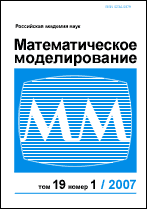|
This article is cited in 1 scientific paper (total in 1 paper)
Numerical simulation of the distribution of vehicle emissions in a street canyon
A. V. Starchenko, E. A. Danilkin, D. V. Leschinsky
Tomsk State University
Abstract:
The results of mathematical modeling of non-isothermal turbulent air flow and admixture
transport in an idealized street canyon are presented. The simulation was based on the
RANS model developed by the authors, the numerical algorithm, and the application
package, which were improved to take into account the effect of the buoyancy force on
aerodynamics and admixture transport. The mathematical model includes Reynolds-averaged stationary three-dimensional Navier-Stokes equations, equations of heat transfer and impurity transfer. For closing, a k-eps turbulence model was chosen taking into
account the buoyancy forces. The numerical algorithm uses the finite volume method,
non-uniform structured grids, and the fictitious domain method. Approximation of the
differential problem is performed using Van Leer's monotonized linear upwind scheme
and piecewise linear interpolation for dependent quantities. The resulting grid equations
were solved sequentially by the iterative method of Buleev N. I. The SIMPLE algorithm
was used to match the velocity and pressure fields. Using the developed package of applied programs, it was found that the least ventilated at low wind velocity ($\sim$ 1 m/s) are
narrow and high street canyons, and the higher the street canyon with a constant width,
the higher the average concentration in the breathing zone. When studying the influence
of the degree of heating of the surfaces of a street canyon, the height and width of which
coincide, the least ventilated case is when the surface temperature of the windward vertical side of the canyon is 15–20$^\circ$ С higher than the ambient temperature. The main reason
for this is the formation of a secondary vortex above the road surface, due to which the
admixture is poorly carried out of the canyon.
Keywords:
RANS model, mixed convection, street canyon, finite volume method, influence of sizes and degree of surface heating, secondary vortices.
Received: 31.03.2022
Revised: 31.03.2022
Accepted: 16.05.2022
Citation:
A. V. Starchenko, E. A. Danilkin, D. V. Leschinsky, “Numerical simulation of the distribution of vehicle emissions in a street canyon”, Matem. Mod., 34:10 (2022), 81–94; Math. Models Comput. Simul., 15:3 (2023), 427–435
Linking options:
https://www.mathnet.ru/eng/mm4412 https://www.mathnet.ru/eng/mm/v34/i10/p81
|

| Statistics & downloads: |
| Abstract page: | 265 | | Full-text PDF : | 56 | | References: | 55 | | First page: | 11 |
|




 Contact us:
Contact us: Terms of Use
Terms of Use
 Registration to the website
Registration to the website Logotypes
Logotypes








 Citation in format
Citation in format 
